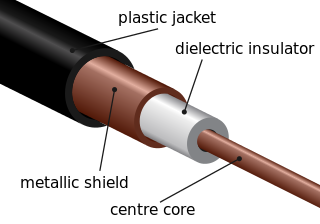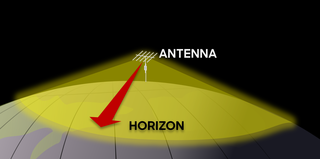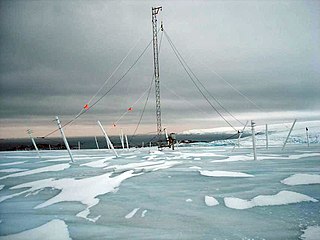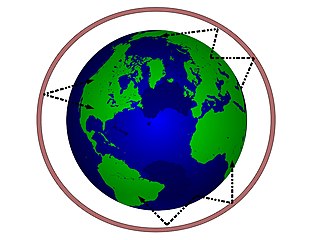
A skip zone, also called a silent zone or zone of silence, is a region where a radio transmission can not be received. The zone is located between regions both closer and farther from the transmitter where reception is possible.

A skip zone, also called a silent zone or zone of silence, is a region where a radio transmission can not be received. The zone is located between regions both closer and farther from the transmitter where reception is possible.
When using medium to high-frequency radio telecommunication, there are radio waves which travel both parallel to the ground, and towards the ionosphere, referred to as a ground wave and sky wave, respectively. A skip zone is an annular region between the farthest points at which the ground wave can be received and the nearest point at which the refracted sky waves can be received. Within this region, no signal can be received because, due to the conditions of the local ionosphere, the relevant sky waves are not reflected but penetrate the ionosphere.
The skip zone is a natural phenomenon that cannot be influenced by technical means. Its width depends on the height and shape of the ionosphere and, particularly, on the local ionospheric maximum electron density characterized by critical frequency foF2. It varies mainly with this parameter, being larger for low foF2. With a fixed working frequency it is large by night and may even disappear by day. Transmitting at night is most effective for long-distance communication but the skip zone becomes significantly larger. Very high frequency waves and higher normally travel through the ionosphere wherefore communication via skywave is exceptional. A highly ionized Es-Layer that occasionally may appear in summer may produce such Sporadic E propagation.

A method of decreasing the skip zone is by decreasing the frequency of the radio waves. Decreasing the frequency is akin to increasing the ionospheric width. A point is eventually reached when decreasing the frequency results in a zero distance skip zone. In other words, a frequency exists for which vertically incident radio waves will always be refracted back to the Earth. This frequency is equivalent to the ionospheric plasma frequency and is also known as the ionospheric critical frequency, or foF2.
Skip zone is the subject of a film 'SKIPZONE' made in 1992 by UK artist, Peter Lee-Jones. It refers to areas in Scottish Highlands where it is difficult to obtain radio and TV reception.[ citation needed ]
In the episode "Short Wave" [1] of Father Knows Best , the family hears a distress call from a small boat at sea. Jim explains that the reason they, and not the Coast Guard, can hear the transmission is because of a "skip".

The ionosphere is the ionized part of the upper atmosphere of Earth, from about 48 km (30 mi) to 965 km (600 mi) above sea level, a region that includes the thermosphere and parts of the mesosphere and exosphere. The ionosphere is ionized by solar radiation. It plays an important role in atmospheric electricity and forms the inner edge of the magnetosphere. It has practical importance because, among other functions, it influences radio propagation to distant places on Earth. It also affects GPS signals that travel through this layer.
The F region of the ionosphere is home to the F layer of ionization, also called the Appleton–Barnett layer, after the English physicist Edward Appleton and New Zealand physicist and meteorologist Miles Barnett. As with other ionospheric sectors, 'layer' implies a concentration of plasma, while 'region' is the volume that contains the said layer. The F region contains ionized gases at a height of around 150–800 km above sea level, placing it in the Earth's thermosphere, a hot region in the upper atmosphere, and also in the heterosphere, where chemical composition varies with height. Generally speaking, the F region has the highest concentration of free electrons and ions anywhere in the atmosphere. It may be thought of as comprising two layers, the F1 and F2 layers.
In radio transmission, maximum usable frequency (MUF) is the highest radio frequency that can be used for transmission between two points on Earth by reflection from the ionosphere at a specified time, independent of transmitter power. This index is especially useful for shortwave transmissions.

A transmission medium is a system or substance that can mediate the propagation of signals for the purposes of telecommunication. Signals are typically imposed on a wave of some kind suitable for the chosen medium. For example, data can modulate sound, and a transmission medium for sounds may be air, but solids and liquids may also act as the transmission medium. Vacuum or air constitutes a good transmission medium for electromagnetic waves such as light and radio waves. While a material substance is not required for electromagnetic waves to propagate, such waves are usually affected by the transmission media they pass through, for instance, by absorption or reflection or refraction at the interfaces between media. Technical devices can therefore be employed to transmit or guide waves. Thus, an optical fiber or a copper cable is used as transmission media.

Shortwave radio is radio transmission using radio frequencies in the shortwave bands (SW). There is no official definition of the band range, but it always includes all of the high frequency band (HF), which extends from 3 to 30 MHz ; above the medium frequency band (MF), to the bottom of the VHF band.

Line-of-sight propagation is a characteristic of electromagnetic radiation or acoustic wave propagation which means waves can only travel in a direct visual path from the source to the receiver without obstacles. Electromagnetic transmission includes light emissions traveling in a straight line. The rays or waves may be diffracted, refracted, reflected, or absorbed by the atmosphere and obstructions with material and generally cannot travel over the horizon or behind obstacles.

Radio waves are a type of electromagnetic radiation with the lowest frequencies and the longest wavelengths in the electromagnetic spectrum, typically with frequencies below 300 gigahertz (GHz) and wavelengths greater than 1 millimeter, about the diameter of a grain of rice. Like all electromagnetic waves, radio waves in a vacuum travel at the speed of light, and in the Earth's atmosphere at a slightly lower speed. Radio waves are generated by charged particles undergoing acceleration, such as time-varying electric currents. Naturally occurring radio waves are emitted by lightning and astronomical objects, and are part of the blackbody radiation emitted by all warm objects.

Very low frequency or VLF is the ITU designation for radio frequencies (RF) in the range of 3–30 kHz, corresponding to wavelengths from 100 to 10 km, respectively. The band is also known as the myriameter band or myriameter wave as the wavelengths range from one to ten myriameters. Due to its limited bandwidth, audio (voice) transmission is highly impractical in this band, and therefore only low data rate coded signals are used. The VLF band is used for a few radio navigation services, government time radio stations and for secure military communication. Since VLF waves can penetrate at least 40 meters (131 ft) into saltwater, they are used for military communication with submarines.

Medium frequency (MF) is the ITU designation for radio frequencies (RF) in the range of 300 kilohertz (kHz) to 3 megahertz (MHz). Part of this band is the medium wave (MW) AM broadcast band. The MF band is also known as the hectometer band as the wavelengths range from ten to one hectometers. Frequencies immediately below MF are denoted as low frequency (LF), while the first band of higher frequencies is known as high frequency (HF). MF is mostly used for AM radio broadcasting, navigational radio beacons, maritime ship-to-shore communication, and transoceanic air traffic control.

In radio, longwave, long wave or long-wave, and commonly abbreviated LW, refers to parts of the radio spectrum with wavelengths longer than what was originally called the medium-wave broadcasting band. The term is historic, dating from the early 20th century, when the radio spectrum was considered to consist of longwave (LW), medium-wave (MW), and short-wave (SW) radio bands. Most modern radio systems and devices use wavelengths which would then have been considered 'ultra-short'.

High frequency (HF) is the ITU designation for the band of radio waves with frequency between 3 and 30 megahertz (MHz). It is also known as the decameter band or decameter wave as its wavelengths range from one to ten decameters. Frequencies immediately below HF are denoted medium frequency (MF), while the next band of higher frequencies is known as the very high frequency (VHF) band. The HF band is a major part of the shortwave band of frequencies, so communication at these frequencies is often called shortwave radio. Because radio waves in this band can be reflected back to Earth by the ionosphere layer in the atmosphere – a method known as "skip" or "skywave" propagation – these frequencies can be used for long-distance communication across intercontinental distances and for mountainous terrains which prevent line-of-sight communications. The band is used by international shortwave broadcasting stations (3.95–25.82 MHz), aviation communication, government time stations, weather stations, amateur radio and citizens band services, among other uses.
A skip distance is the distance a radio wave travels, usually including a hop in the ionosphere. A skip distance is a distance on the Earth's surface between the two points where radio waves from a transmitter, refracted downwards by different layers of the ionosphere, fall. It also represents how far a radio wave has travelled per hop on the Earth's surface, for radio waves such as the short wave (SW) radio signals that employ continuous reflections for transmission.
TV DX and FM DX is the active search for distant radio or television stations received during unusual atmospheric conditions. The term DX is an old telegraphic term meaning "long distance."
Radio propagation is the behavior of radio waves as they travel, or are propagated, from one point to another in vacuum, or into various parts of the atmosphere. As a form of electromagnetic radiation, like light waves, radio waves are affected by the phenomena of reflection, refraction, diffraction, absorption, polarization, and scattering. Understanding the effects of varying conditions on radio propagation has many practical applications, from choosing frequencies for amateur radio communications, international shortwave broadcasters, to designing reliable mobile telephone systems, to radio navigation, to operation of radar systems.

In radio communication, skywave or skip refers to the propagation of radio waves reflected or refracted back toward Earth from the ionosphere, an electrically charged layer of the upper atmosphere. Since it is not limited by the curvature of the Earth, skywave propagation can be used to communicate beyond the horizon, at intercontinental distances. It is mostly used in the shortwave frequency bands.
Super high frequency (SHF) is the ITU designation for radio frequencies (RF) in the range between 3 and 30 gigahertz (GHz). This band of frequencies is also known as the centimetre band or centimetre wave as the wavelengths range from one to ten centimetres. These frequencies fall within the microwave band, so radio waves with these frequencies are called microwaves. The small wavelength of microwaves allows them to be directed in narrow beams by aperture antennas such as parabolic dishes and horn antennas, so they are used for point-to-point communication and data links and for radar. This frequency range is used for most radar transmitters, wireless LANs, satellite communication, microwave radio relay links, satellite phones, and numerous short range terrestrial data links. They are also used for heating in industrial microwave heating, medical diathermy, microwave hyperthermy to treat cancer, and to cook food in microwave ovens.
DXing, taken from DX, the telegraphic shorthand for "distance" or "distant", is the hobby of receiving and identifying distant radio or television signals, or making two-way radio contact with distant stations in amateur radio, citizens band radio or other two-way radio communications. Many DXers also attempt to obtain written verifications of reception or contact, sometimes referred to as "QSLs" or "veries".
Non-line-of-sight (NLOS) radio propagation occurs outside of the typical line-of-sight (LOS) between the transmitter and receiver, such as in ground reflections. Near-line-of-sight conditions refer to partial obstruction by a physical object present in the innermost Fresnel zone.
Near vertical incidence skywave, or NVIS, is a skywave radio-wave propagation path that provides usable signals in the medium distances range — usually 0–650 km. It is used for military and paramilitary communications, broadcasting, especially in the tropics, and by radio amateurs for nearby contacts circumventing line-of-sight barriers. The radio waves travel near-vertically upwards into the ionosphere, where they are refracted back down and can be received within a circular region up to 650 km from the transmitter. If the frequency is too high, refraction is insufficient to return the signal to earth and if it is too low, absorption in the ionospheric D layer may reduce the signal strength.
This is an index to articles about terms used in discussion of radio propagation.